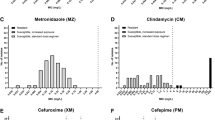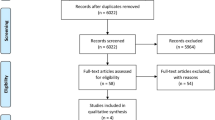Abstract
Background
Titanium and polyether-ether-ketone (PEEK) interbody cages are commonly used for spine fusion. Few data are known about bacterial and yeast biofilms formation in these implants. The aim of this study was to compare Staphylococcus aureus and Candida albicans biofilm formation in the surface of two different interbody devices used routinely in spine surgery.
Methods
Six bodies of proof specimens of PEEK and titanium alloy were used for microbiological tests, scanning electron microscopy, and energy-dispersive X-ray spectroscopy. Experimental biofilm was produced with Staphylococcus aureus and Candida albicans, followed by quantitative analysis of planktonic cells and sessile cells. The comparison between the medians of biofilm quantification between the two models was performed using the Mann–Whitney test and considered the statistical difference for a p < 0.05.
Results
In the S. aureus model, in both planktonic and sessile cell counts, titanium-alloy samples showed lower values for colony forming units per milliliter (UFC/mL) (p < 0.05). The evaluation through the optic density of planktonic and sessile cells showed lower values in the titanium-alloy samples, however, only statistically significant in planktonic cell count (p < 0.05). The count of planktonic yeast cells in PEEK was similar to titanium-alloy samples, while the count of sessile yeast cells in titanium alloy was lower when compared to PEEK (p < 0.05).
Conclusion
Titanium-alloy models were associated with less staphylococcal and Candida biofilm formation when compared with PEEK.






Similar content being viewed by others
Availability of data and material
The data are 100% available. We can easily share if necessary.
References
Darouiche RO (2004) Treatment of infections associated with surgical implants. N Engl J Med 350(14):1422–1429. https://doi.org/10.1056/NEJMra035415
Patel H, Khoury H, Girgenti D, Welner S, Yu H (2017) Burden of surgical site infections associated with select spine operations and involvement of staphylococcus aureus. Surg Infect (Larchmt) 18(4):461–473. https://doi.org/10.1089/sur.2016.186
Peleg AY, Hogan DA, Mylonakis E (2010) Medically important bacterial-fungal interactions. Nat Rev Microbiol 8(5):340–349. https://doi.org/10.1038/nrmicro2313
Pokorny D, Fulin P, Slouf M, Jahoda D, Landor I, Sosna A (2010) Polyetheretherketone (PEEK). Part II: application in clinical practice. Acta Chir Orthop Traumatol Cech 77(6):470–478
Romling U, Balsalobre C (2012) Biofilm infections, their resilience to therapy and innovative treatment strategies. J Intern Med 272(6):541–561. https://doi.org/10.1111/joim.12004
Sivasubramaniam V, Patel HC, Ozdemir BA, Papadopoulos MC (2015) Trends in hospital admissions and surgical procedures for degenerative lumbar spine disease in England: a 15-year time-series study. BMJ Open 5(12):e009011. https://doi.org/10.1136/bmjopen-2015-009011
Street TL, Sanderson ND, Atkins BL, Brent AJ, Cole K, Foster D, McNally MA, Oakley S, Peto L, Taylor A, Peto TEA, Crook DW, Eyre DW (2017) Molecular diagnosis of orthopedic-device-related infection directly from sonication fluid by metagenomic sequencing. J Clin Microbiol 55(8):2334–2347. https://doi.org/10.1128/JCM.00462-17
Terada A, Okuyama K, Nishikawa M, Tsuneda S, Hosomi M (2012) The effect of surface charge property on Escherichia coli initial adhesion and subsequent biofilm formation. Biotechnol Bioeng 109(7):1745–1754. https://doi.org/10.1002/bit.24429
Teughels W, Van Assche N, Sliepen I, Quirynen M (2006) Effect of material characteristics and/or surface topography on biofilm development. Clin Oral Implants Res 17(Suppl 2):68–81. https://doi.org/10.1111/j.1600-0501.2006.01353.x
Trampuz A, Piper KE, Jacobson MJ, Hanssen AD, Unni KK, Osmon DR, Mandrekar JN, Cockerill FR, Steckelberg JM, Greenleaf JF, Patel R (2007) Sonication of removed hip and knee prostheses for diagnosis of infection. N Engl J Med 357(7):654–663. https://doi.org/10.1056/NEJMoa061588
De Bruyn H, Christiaens V, Doornewaard R, Jacobsson M, Cosyn J, Jacquet W (2000) Vervaeke S (2017) Implant surface roughness and patient factors on long-term peri-implant bone loss. Periodontol 73(1):218–227. https://doi.org/10.1111/prd.12177
Li B, Logan BE (2004) Bacterial adhesion to glass and metal-oxide surfaces. Colloids Surf B Biointerfaces 36(2):81–90. https://doi.org/10.1016/j.colsurfb.2004.05.006
Grenho L, Salgado CL, Fernandes MH, Monteiro FJ, Ferraz MP (2015) Antibacterial activity and biocompatibility of three-dimensional nanostructured porous granules of hydroxyapatite and zinc oxide nanoparticles–an in vitro and in vivo study. Nanotechnology 26(31):315101. https://doi.org/10.1088/0957-4484/26/31/315101
Bock RM, Jones EN, Ray DA, Sonny Bal B, Pezzotti G, McEntire BJ (2017) Bacteriostatic behavior of surface modulated silicon nitride in comparison to polyetheretherketone and titanium. J Biomed Mater Res A 105(5):1521–1534. https://doi.org/10.1002/jbm.a.35987
Webster TJ, Patel AA, Rahaman MN, Sonny Bal B (2012) Anti-infective and osteointegration properties of silicon nitride, poly(ether ether ketone), and titanium implants. Acta Biomater 8(12):4447–4454. https://doi.org/10.1016/j.actbio.2012.07.038
Burgers R, Hahnel S, Reichert TE, Rosentritt M, Behr M, Gerlach T, Handel G, Gosau M (2010) Adhesion of Candida albicans to various dental implant surfaces and the influence of salivary pellicle proteins. Acta Biomater 6(6):2307–2313. https://doi.org/10.1016/j.actbio.2009.11.003
Tan JH, Cheong CK, Hey HWD (2021) Titanium (Ti) cages may be superior to polyetheretherketone (PEEK) cages in lumbar interbody fusion: a systematic review and meta-analysis of clinical and radiological outcomes of spinal interbody fusions using Ti versus PEEK cages. Eur Spine J. https://doi.org/10.1007/s00586-021-06748-w
Garcia D, Mayfield CK, Leong J, Deckey DG, Zega A, Glasser J, Daniels AH, Eberson C, Green A, Born C (2020) Early adherence and biofilm formation of Cutibacterium acnes (formerly Propionibacterium acnes) on spinal implant materials. Spine J 20(6):981–987. https://doi.org/10.1016/j.spinee.2020.01.001
Cieslinski J, Ribeiro VST, Kraft L, Suss PH, Rosa E, Morello LG, Pillonetto M, Tuon FF (2021) Direct detection of microorganisms in sonicated orthopedic devices after in vitro biofilm production and different processing conditions. Eur J Orthop Surg Traumatol. https://doi.org/10.1007/s00590-020-02856-3
Kratzig T, Mende KC, Mohme M, von Kroge S, Stangenberg M, Dreimann M, Westphal M, Weisselberg S, Eicker SO (2021) Bacterial adhesion characteristics on implant materials for intervertebral cages: titanium or PEEK for spinal infections? Eur Spine J. https://doi.org/10.1007/s00586-020-06705-z
Garcia DR, Deckey DG, Zega A, Mayfield C, Spake CSL, Emanuel T, Daniels A, Jarrell J, Glasser J, Born CT, Eberson CP (2020) Analysis of growth and biofilm formation of bacterial pathogens on frequently used spinal implant materials. Spine Deform 8(3):351–359. https://doi.org/10.1007/s43390-020-00054-z
Tuon FF, Cieslinski J, Ono AFM, Goto FL, Machinski JM, Mantovani LK, Kosop LR, Namba MS, Rocha JL (2019) Microbiological profile and susceptibility pattern of surgical site infections related to orthopaedic trauma. Int Orthop 43(6):1309–1313. https://doi.org/10.1007/s00264-018-4076-7
Marsh PD, Moter A (2000) Devine DA (2011) Dental plaque biofilms: communities, conflict and control. Periodontol 55(1):16–35. https://doi.org/10.1111/j.1600-0757.2009.00339.x
Li Y, Guo T, Zhao J, Wang J (2013) Effects of polishing methods on Candida albicans adhesion on cast pure titanium surfaces. Implant Dent 22(5):546–551. https://doi.org/10.1097/ID.0b013e3182a03ce9
Bosshardt DD, Chappuis V (2000) Buser D (2017) Osseointegration of titanium, titanium alloy and zirconia dental implants: current knowledge and open questions. Periodontol 73(1):22–40. https://doi.org/10.1111/prd.12179
Donlan RM (2001) Biofilms and device-associated infections. Emerg Infect Dis 7(2):277–281. https://doi.org/10.3201/eid0702.700277
Donlan RM, Costerton JW (2002) Biofilms: survival mechanisms of clinically relevant microorganisms. Clin Microbiol Rev 15(2):167–193
Dabdoub SM, Tsigarida AA, Kumar PS (2013) Patient-specific analysis of periodontal and peri-implant microbiomes. J Dent Res 92(12 Suppl):168S-175S. https://doi.org/10.1177/0022034513504950
Acknowledgements
We thank to Fundação Araucária and Associação Paranaense de Cultura (APC) (CP 10/2019)
Funding
All the costs were covered by the main author.
Author information
Authors and Affiliations
Contributions
All the authors agree with rules of the submission. Our research is an in vitro study.
Corresponding author
Ethics declarations
Conflicts of interest statement
F. F Tuon is a CNPq researcher. The other authors state that there is no conflict of interest.
Ethics approval
No need for ethics approval in our facility as the research was an in vitro study.
Consent to participate
All the authors agree and consented to participate.
Consent for publication
All the authors consent with the publication.
Additional information
Publisher's Note
Springer Nature remains neutral with regard to jurisdictional claims in published maps and institutional affiliations.
Rights and permissions
About this article
Cite this article
da Rocha, L.G.D.O., Ribeiro, V.S.T., de Andrade, A.P. et al. Evaluation of Staphylococcus aureus and Candida albicans biofilms adherence to PEEK and titanium-alloy prosthetic spine devices. Eur J Orthop Surg Traumatol 32, 981–989 (2022). https://doi.org/10.1007/s00590-021-03069-y
Received:
Accepted:
Published:
Issue Date:
DOI: https://doi.org/10.1007/s00590-021-03069-y




